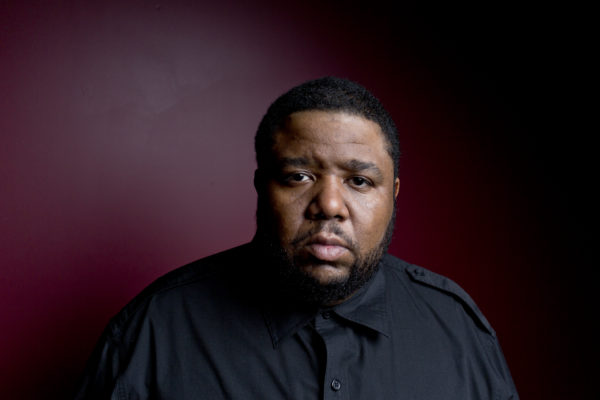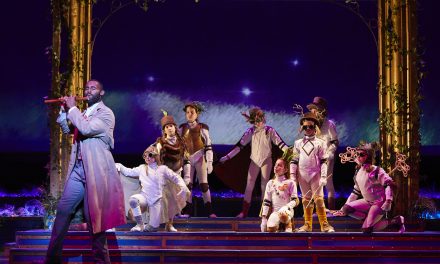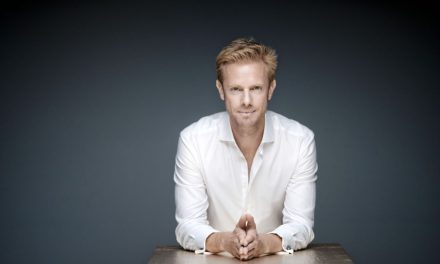Tyshawn Sorey. Photo: John Rogers
The Jazz Influence: Festival of New American Music II
The Louisville Orchestra
Teddy Abrams, conductor and solo pianist
Measha Brueggergosman, Emily Black and Haley DeWitt, vocalists
U of L Student Jazz Quintet: Blase Groody – tenor saxophone, Isaac Stephens – trumpet, Chad O’Brien – trombone, Jailynn Lake – bass, Pedro Augusto – drumset
Ansyn Banks, trumpet
Craig Wagner, electric guitar
Review by Annette Skaggs
Entire contents are copyright © 2019 Annette Skaggs. All rights reserved.
Two weeks ago Louisville audiences were treated to the first weekend of the Festival of New American Music. It featured the beloved Martha Graham choreography of Aaron Copeland’s Appalachian Spring, expertly and movingly performed by the Louisville Ballet. Also on the bill was a lovely piece by local composer Rachel Grimes titled The Way Forth, which was a trip into some of Ms. Grimes’ and our collective histories of Kentucky life.
This past weekend the festival was rounded out with a focus on jazz that included two new commissioned works by the Louisville Orchestra: Gabriel Evens’ Run for It and Tyshawn Sorey’s For Bill Dixon and A. Spencer Barefield. Michael Tilson Thomas’ Four Preludes on Playthings of the Wind, was also featured, as well as a crown jewel of the American Songbook, George Gershwin’s Rhapsody in Blue.
Mr. Evens, currently teaches Jazz Piano, Composition and Arranging at the University of Louisville as part of the Jamey Aebersold Jazz Studies Program. A talented pianist who holds degrees from Miami and Texas, Mr. Evens has 7 CDs of original music to his credit and has performed all over the world.
The program notes tout that Run For It is a hard-driving, frenetic composition for jazz quintet and orchestra, but after five or so measure of a full orchestral sound, there is a dampening that then leads to a score that seems to change time signatures on a dime, adding a bit of urgency. That urgency is the beginning of the shine of the piece: the jazz quintet, featuring students from the Jazz Studies Program brimming with talent. Jailynn Lake’s bass and Pedro Augusto’s percussion never lost focus and served as the rhythm and center for the quintet. Blase Groody’s tenor saxophone was fun and bubbly. Isaac Stephens on trumpet was absolutely fantastic. His command of breath and focus was pointed and professional. Unfortunately, despite how important the trombone solo was to the piece on the whole as it bridged the jazz to the orchestra, or how well Chad O’Brien performed, I did not care for the solo. It sounded like when a child first receives an instrument and they play around with it. To be honest, that was the only part that I had an issue with and it really isn’t that big of an issue, just not to my taste. The combination of the jazz quintet and the full orchestra was cohesive and intriguing. I dare say that I heard a familiar theme thrown into the horn section: was that a little of Henry Mancini’s Pink Panther?
During the introduction of the evening’s next commissioned work, For Bill Dixon and A. Spencer Barefield, Mr. Abrams shared with the audience his excitement to be able to feature the work of its composer, Tyshawn Sorey. Mr. Sorey is a multi-instrumentalist from Newark who has created a body of work that is celebrated worldwide for its complexity and virtuosity. His work performed by our Louisville Orchestra was certainly no exception. Mr. Sorey’s piece is considered to highlight spectral sound. What that means is that each sound is allowed to live within its moment. It may linger for a while or it may fade away as quickly as it arrived. The piece is filled with unusual sonorities and even stranger note combinations. Often times while listening to this visionary piece I would have to double check my mind to try and figure out what note or notes that I think I just heard, keeping an inner dialogue to myself with questions like “I didn’t know a note between flat and sharp existed.” Such was the game that was played within this exceptionally marvelous and multifaceted performance. Featuring the talents of Ansyn Banks on trumpet and Craig Wagner on electric guitar, this piece tested the limits of sounds that all the instruments were capable of creating. I believe I even heard the plucking of the piano’s wires at one point. There was a moment within the piece that Mr. Abrams lowered his arms and allowed our guest trumpeter and guitarist to lead and fill Whitney Hall with a sound that seemed to cross space and time. A performance such as this becomes a true testament to our Orchestra and artistic community truly is.
As told directly from Mr. Tilson Thomas in a pre-recorded message, Four Preludes on Playthings of the Wind was born from a poem that he became enamored with in the “Smoke and Steele” collection of American poet Carl Sandburg. Setting the poem to music was something that he noodled around with for a bit, but didn’t give full attention until 2016, when he completed the work. He shared with us that vocally Sarah Vaughn, Leontyne Price, James Brown, and Igor Stravinsky inspired the piece. To capture these influences he found the perfect vocalist in Measha Brueggergosman, who is a fount of talent. Instrumentally, Preludes is part orchestra, part bar band, and part pop band which are all canvassed in an entertaining back and forth way.
The poem is a stark look at mankind’s propensity to create tributes to itself: statues, pyramids, etc., and in the end, what happens to them. Have we truly memorialized ourselves for eternity or are we just crumbled stones and dust that blows away?
Another difficult work to be sure, but there was some sheer brilliance in the weaving of the different styles. Within the first movement, there was a synthesizer sound that made me think of mankind’s assumed beginnings coming out of primordial ooze. Then rays of light begin to shine as pop music fills the air. Ms. Brueggergossman, hiding among the violins, suddenly arises in a gold, glittery dress, and cries to the audience “The past is a bucket of ashes”.
The piece was certainly enjoyable and had moments of sheer brilliance. Guest soloist Ms. Brueggergosman was absolutely stunning and expertly aided by other vocalists Emily Black and Haley DeWitt. However, I feel that the choreography left a lot to be desired. It truly didn’t fit the body of work.
It isn’t necessarily a piece that we are all going to walk around humming its theme, but it certainly made me want to revisit Sandburg’s works again.
Are there any other orchestral openings as sexy as the solo clarinet glissando of George Gershwin’s Rhapsody in Blue? A handful maybe, but when you hear that glide you instantly recognize the piece. This iconic music features solo piano and a jazz ensemble, which for our purposes of turns into a full orchestral work. Clad in blue socks to fit the theme, Teddy Abrams took the responsibility of both conductor and solo pianist. A daunting task to be sure, but knowing our music director’s talent I had no doubt of his success. And successful it was.
Rhapsody requires a virtuosic skill set for the pianist, with the ability to improvise and conduct the band, or orchestra in our case. Luckily, Teddy has such a skill set. As Teddy would rise and fall to conduct this masterpiece, there were moments that I believe concertmaster Gabriel Lefkowitz would assist in leading by heightening his head movements prior to a string, wind and/or percussive entrance.
Passion, energy, and fun are essential ingredients for performing such an iconic composition, and that enjoyment was evident on the faces of the members of the orchestra.
Now as wonderful as this performance was and very deserving of the numerous rounds of applause and standing ovations that it received, I have to nitpick a little. I know firsthand how one can get carried away in the performance of a piece like this and I believe Mr. Abrams may have fallen victim to that. There were moments that the piano pedals were hit so hard that it added an unneeded percussion, including the sound that is made when the pedal bounces back from its spring.
Amazing to think that when Gershwin was commissioned to do this work it was considered an experiment. I believe that it is safe to say that it is one of the most successful experiments in musical history.
Thank you to all of the guest musicians, vocalists, composers and our Louisville Orchestra for a magical evening of music that expanded our minds and our ears.
Bravi Tutti!!
The Jazz Influence: Festival of New American Music II
March 9, 2019
Louisville Orchestra
Kentucky Center for the Performing Arts
Whitney Hall
501 W. Main St
Louisville, KY 40202
louisvilleorchestra.org
Annette Skaggs is heavily involved as an Arts Advocate here in Louisville. She is a freelance professional opera singer who has performed throughout Europe and in St. Louis, Cincinnati, Boulder, Little Rock, Peoria, Chicago, New York and of course Louisville. Aside from her singing career, she has been a production assistant for Kentucky Opera, New York City Opera, and Northwestern University. Her knowledge and expertise have developed over the course of 25+ years’ experience in the classical arts.
2019 Arts-Louisville/Broadway World Theatre Award Sponsorship provided by







